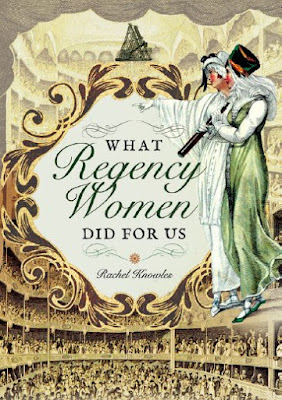
Today is the UK release date for my new book, What Regency Women Did For Us. The book tells the inspirational stories of twelve women who lived in the Regency period – women whose lives made an impact on the world in which they lived and whose influence can still be felt in some measure today. These women were pioneers for their sex – scientists and authors, actresses and educators, philanthropists and businesswomen – and some of them going where no woman had been before.
Twelve inspirational Regency women
Eleanor Coade was a successful businesswoman who ran an artificial stone manufactory. Coade stone was used to make statues and decorative plaques, many examples of which have survived into the 21st century. You may, perhaps, have seen some of her Coade stone without even realising it. Could you tell that this statue of the River God at Ham House in Richmond, London, was made of Coade stone?
 |
| River God statue at Ham House, Richmond |
Sarah Siddons was the most famous tragic actress of her time, playing parts such as Lady Macbeth so convincingly that female members of her audience were sometimes sent into hysterics. But it was her respectability that really made a difference to the position of female actors.
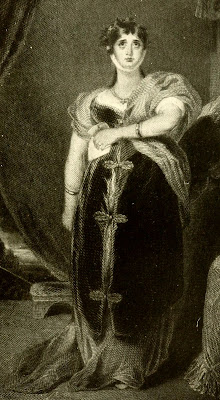 |
| Sarah Siddons as Lady Macbeth after painting by GH Harlow |
Marie Tussaud was probably the most successful female entrepreneur of her time. She came to England after the French Revolution and travelled widely with her waxworks exhibition before eventually settling in London. Madame Tussauds is still a big tourist attraction in London today. But what was it about Marie’s business that set it apart from those of her rivals and helped it to survive into the 21st century?
Mary Parminter was very unusual for a wealthy Georgian woman. Not only did she choose not to get married; together with her sister and cousin, Jane, she went on a Grand Tour of Europe. But their idea of a Grand Tour was not just seeing the regular sights – it included 200 miles of walking in the Alps and climbing Mont Buet! Perhaps it was hardly surprising that the house that Mary and Jane built when they returned – A la Ronde – was also not what you would have expected.
Maria Edgeworth is little known today, but in her time, she was much better known than Jane Austen, and much more financially successful. Though her books have largely been forgotten, she is credited with being the inventor of historical fiction – a genre which we take for granted today.
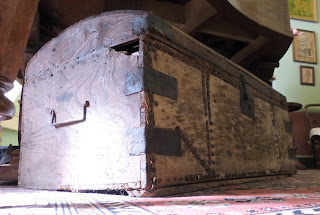 |
| Packing case on display at A la Ronde |
Jane Marcet attended lectures in chemistry at the Royal Institution, but struggled to understand them without her husband’s help. She realised that many women did not have her advantages and decided to write a simple textbook using everyday language to share her new-found knowledge – a ‘Dummies Guide’ to Chemistry. Although intended for a female audience, it was not only women who were influenced by her work.
Sarah Guppy was a talented scientist and inventor who, even though she was a woman, mixed with and influenced some of the leading scientists of her day. Just how much she had to do with the design of the Clifton Suspension Bridge remains open to conjecture.
Jane Austen is the only one of the twelve women who did not live through the whole Regency period. All her books were, however, published during the Regency, and were popular with the Prince Regent (later George IV) who was such a big fan that Jane felt obliged to dedicate Emma to him. I wonder what Jane would have thought of the worldwide industry that ‘love of Jane Austen’ has become?
Harriot Mellon’s life is a real-life rags to Regency riches story. Starting out life with a band of touring players, she rose to some measure of success on the stage due to a good memory, a pretty face and a pushy mother. But her life changed forever when the wealthy banker Thomas Coutts became her ‘fairy godfather’.
Elizabeth Fry was only the second woman to be depicted on a British banknote, in remembrance of her pioneering work in prison reform. Perhaps less well known is that some also consider her to be the founder of modern nursing.
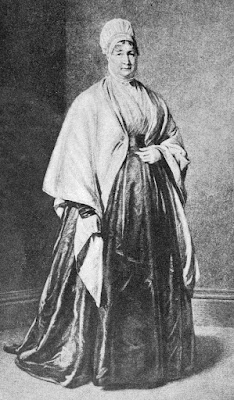 |
| Elizabeth Fry from Elizabeth Fry, the angel of the prisons by LE Richards (1916) |
Mary Anning lived all her life in Lyme Regis in Dorset and became an expert fossil finder. But did you know that Mary was famous long before she found her first fossil? Her miraculous escape from death as a baby was often cited in local guidebooks at the time.
You can read the stories of all these women in What Regency Women Did For Us.
Available direct from Pen and Sword history books here.

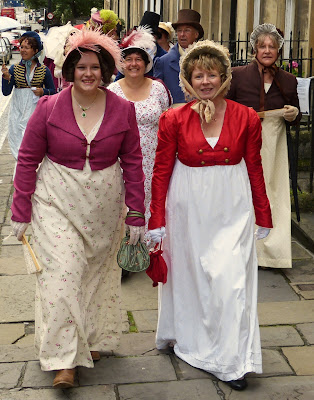
Just bought it for my kindle. Looking forward to reading it.
ReplyDeleteI hope you enjoy it. :)
DeleteI want it for myself and I see it as a great gift for a friend, too!
ReplyDeleteThanks, Suzan. :)
DeleteSounds wonderful! Running over to Amazon!
ReplyDeleteThank you - enjoy :)
DeleteHello, I am really enjoying this book! Thank you for bringing light to so many fascinating women.
ReplyDeleteA quick question though. I live on Camberwell Grove, as did Eleanor Coade at the time of her death. Do you happen to know the address of the home she lived in? And were there any pieces of Coade stone used in this area? I'm so excited that a pioneering businesswoman lived on my street! Would love to know more about her life here if you have any information?
Thank you!
Thank you so much for your lovely comment. I was feeling rather down after reading some lousy reviews of my book on Goodreads and you have really cheered me up. The most comprehensive book on Eleanor Coade and Coade stone is Alison Kelly's 'Mrs Coade's Stone' - it is out of print and quite hard to get hold of but you might be able to borrow it from your library. I am afraid I have nothing more definite than that she was described as being 'of Camberwell Grove' at the time of her death. Previous to this, she lived in Great Surrey Street, now Blackfriars Road. There are Coade stone plaques on 86 Camberwell Road which I think should be near you.
DeleteIgnore GoodReads. Very spiteful people leave reviews there! Amazon reviews are great! I will be downloading today.
DeleteGosh, that was a really fast surprise. thank you for that! Please don't let the Goodreads reviews get you down - I can't imagine working on something like this book and pouring yourself into it to receive negative feedback. I, for one, have been really inspired by it and have only just discovered this blog. It is brilliant, and your love of the subject really shows through.
ReplyDeleteI've just had a look on Google maps and 86 Camberwell Grove is only 120 yards from my house. Will investigate this afternoon! Shall i take a photo to share with you?
Keep up the good work and "Don't let the bastards get you down"! X
I just finished reading this book and I enjoyed it immensely. The level was just right for the person who mostly reads fiction but wants an entertaining nonfiction background and is curious about the subject matter. It appeared to be well-researched and the stories were told in a very entertaining manner. Thanks so much for bringing it to us. I'd love a sequel, as I'm sure there were other women who did not make the cut this time!
ReplyDeleteI'm so glad you enjoyed the book. I've found it quite hard to describe the level of reader it is aimed at, but you do it brilliantly. Thanks very much.
DeleteI've only just seen this post as I've come through your newsletter to the blog. Don't be downhearted about the reviews on GoodReads. I was interested to see how it was received on Amazon and you have some very good reviews on that site. I've had it in my wish list for a while, as I love the Regency period, and as soon as I can afford it I'll be purchasing it. I also review every book I read.
ReplyDeleteThank you very much for the encouragement.
Delete